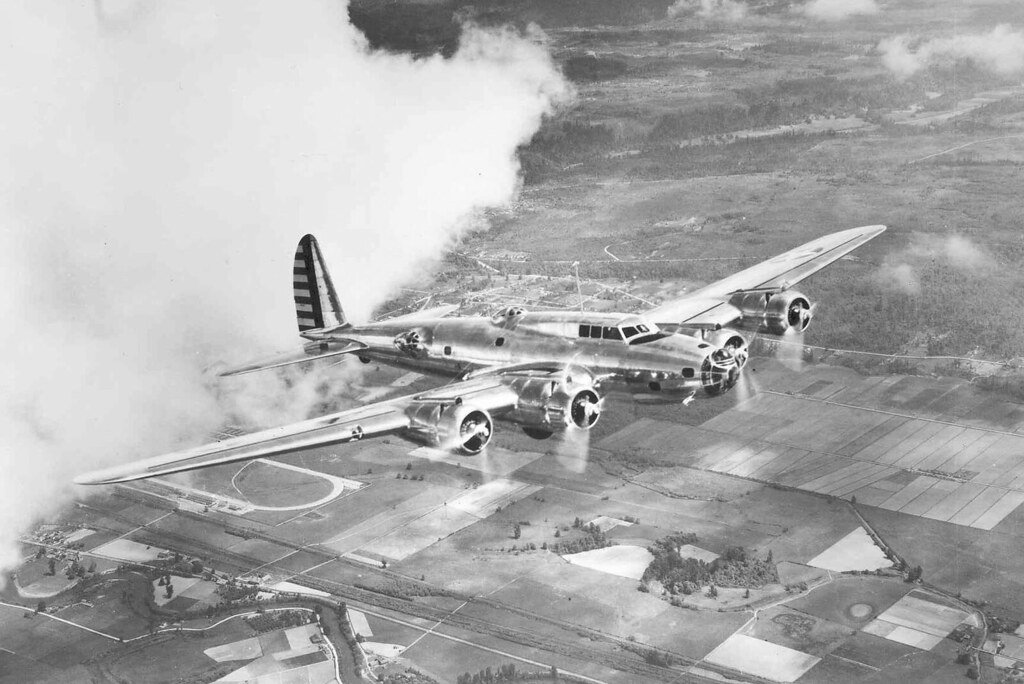
Описание: Boeing B-17 "Flying Fortress" The initial flight of the aircraft took place on 2-Dec-36, but with Stan Umstead, five days later nosed over during landed but was not too badly damaged. Delivered 49BS/2BG Langley 1-Mar-37; 4000 Base Unit Wright Fd 1938; transferred 19BG March Fd, Oct... 7 December 1936: After its third test flight, the first YB-17 service test aircraft, S/N 36-149, landed back at Boeing Field, Seattle, Washington. The pilot was Lieutenant Colonel Stanley M. Umstead, Air Corps, United States Army, who was considered to be the Army’s most experienced and capable pilot. When the airplane touched down, the main wheels locked and after skidding a short distance, the B-17 nosed over. The bomber’s brakes had welded. No injuries were reported. 36-149 suffered moderate damage. Boeing repaired the bomber. On 11 January 1937, the YB-17 was flown to Wright Field, Dayton, Ohio, for continued testing. 36-149 was then assigned to the 2nd Bombardment Group at Langley Field, Virginia, 1 March 1937. In October 1940 the bomber was transferred to the 19th Bombardment Group at March Field, California. On 11 February 1942 it was transferred to the Air Park at Amarillo Army Air Field, a B-17 training base in Texas. 36-149 was written off 11 December 1942. The YB-17 had several improvements over the Model 299, which had been retroactively designated XB-17. There were long carburetor intakes on the top of the engine nacelles, which visually distinguishes the YB-17 from the follow-on YB-17A. The main landing gear has one strut rather than the two of the Model 299. The Boeing Model 299B was designated YB-17 by the Army Air Corps. It was 68 feet, 4 inches (20.828 meters) long with a wingspan of 103 feet, 9 3/8 inches (31.633 meters) and an overall height of 18 feet, 4 inches (5.588 meters). It had an empty weight of 24,465 pounds (11,097 kilograms), gross weight of 34,880 pounds (15,821 kilograms) and maximum takeoff weight of 42,600 pounds (19,323 kilograms). Instead of the Pratt & Whitney engines installed on the 299, the YB-17 had four air-cooled, supercharged 1,823.129-cubic-inch-displacement (29.875 liter) Wright Aeronautical Division Cyclone 9 R-1820G5 (R-1820-39) nine-cylinder radial engines with a compression ratio of 6.45:1. The R-1820-39 was rated at 805 horsepower at 2,100 r.p.m., at Sea Level, and 930 horsepower at 2,200 r.p.m., at Sea Level, for takeoff. The engines turned three-bladed Hamilton Standard constant-speed propellers through a 16:11 gear reduction, in order to match the engines’ effective power range with the propellers. The R-1820-39 was 3 feet, 9-7/16 inches (1.154 meters) long, 4 feet, 6- 1/4 inches (1.378 meters) in diameter, and weighed 1,198 pounds (543.4 kilograms). The cruise speed of the YB-17 was 217 miles per hour (349 kilometers per hour) and its maximum speed was 256 miles per hour (412 kilometers per hour) at 14,000 feet (4,267 meters). The bomber’s service ceiling was 30,600 feet (9,327 meters) and the maximum range was 3,320 miles (5,343 kilometers). The YB-17 could carry 8,000 pounds (3,629 kilograms) of bombs. Defensive armament consisted of five .30-caliber air-cooled machine guns. Although the prototype Boeing Model 299, NX13372, had crashed at Wright Field, Ohio, 30 October 1935, the Army had ordered thirteen Y1B-17 service test aircraft, serials 36-149–36-161. Prior to the model’s first flight, this designation was changed to YB-17. (The “-1-” in the original Y1B-17 designation indicated that the service test bombers were ordered using funding other than the normal appropriations for new aircraft.) S/N 36-149 was damaged in a landing accident 7 December 1936. It was repaired and then flown to Wright Field, Dayton, Ohio, 11 January 1937. After testing at Wright Field, 36-149 was delivered to the 2nd Bombardment Group, Langley Field, Virginia. By 1938 the bomber was back at Wright Field for additional tests. In October 1940 S/N 36-149 was transferred to the 19th Bombardment Group at March Field, California. Finally, on 11 February 1942, it was transferred to the Air Park at Amarillo Army Air Field, a B-17 training base in Texas. It was written off 11 December 1942. After several years of testing, the YB-17 went into production as the B-17 Flying Fortress. By the end of World War II, 12,731 B-17s had been built by Boeing, Douglas and Lockheed Vega.
Tags:
Поиск и фотоизображения предоставлены компанией Flickr с помощью сервиса Flickr API согласно Правилам пользования сайтом Flick.com и его сервисами. Графические изображения являются публичными, размещёнными их авторами в свободный доступ (Public) и физически расположены на серверах Flickr. Все права на фотографии принадлежат их авторам согласно пользовательскому соглашению сервиса Flickr.com и охраняются законами, регулирующими авторские права.